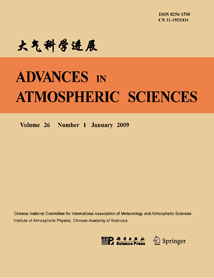| [1] |
YANG Shili, FENG Jinming, DONG Wenjie, CHOU Jieming,
2014: Analyses of Extreme Climate Events over China Based on CMIP5 Historical and Future Simulations, ADVANCES IN ATMOSPHERIC SCIENCES, 31, 1209-1220.
doi: 10.1007/s00376-014-3119-2
|
| [2] |
REN Guoyu, DING Yihui, ZHAO Zongci, ZHENG Jingyun, WU Tongwen, TANG Guoli, XU Ying,
2012: Recent Progress in Studies of Climate Change in China, ADVANCES IN ATMOSPHERIC SCIENCES, 29, 958-977.
doi: 10.1007/s00376-012-1200-2
|
| [3] |
Dabang JIANG, Dan HU, Zhiping TIAN, Xianmei LANG,
2020: Differences between CMIP6 and CMIP5 Models in Simulating Climate over China and the East Asian Monsoon, ADVANCES IN ATMOSPHERIC SCIENCES, 37, 1102-1118.
doi: 10.1007/s00376-020-2034-y
|
| [4] |
HE Jinhai, JU Jianhua, WEN Zhiping, L\"U Junmei, JIN Qihua,
2007: A Review of Recent Advances in Research on Asian Monsoon in China, ADVANCES IN ATMOSPHERIC SCIENCES, 24, 972-992.
doi: 10.1007/s00376-007-0972-2
|
| [5] |
Congwen ZHU, Boqi LIU, Kang XU, Ning JIANG, Kai LIU,
2021: Diversity of the Coupling Wheels in the East Asian Summer Monsoon on the Interannual Time Scale: Challenge of Summer Rainfall Forecasting in China, ADVANCES IN ATMOSPHERIC SCIENCES, 38, 546-554.
doi: 10.1007/s00376-020-0199-z
|
| [6] |
JIANG Dabang, YU Ge, ZHAO Ping, CHEN Xing, LIU Jian, LIU Xiaodong, WANG Shaowu, ZHANG Zhongshi, YU Yongqiang, LI Yuefeng, JIN Liya, XU Ying, JU Lixia, ZHOU Tianjun, YAN Xiaodong,
2015: Paleoclimate Modeling in China: A Review, ADVANCES IN ATMOSPHERIC SCIENCES, 32, 250-275.
doi: 10.1007/s00376-014-0002-0
|
| [7] |
GUO Xueliang, FU Danhong, LI Xingyu, HU Zhaoxia, LEI Henchi, XIAO Hui, HONG Yanchao,
2015: Advances in Cloud Physics and Weather Modification in China, ADVANCES IN ATMOSPHERIC SCIENCES, 32, 230-249.
doi: 10.1007/s00376-014-0006-9
|
| [8] |
DING Ting, QIAN Weihong,
2011: Geographical Patterns and Temporal Variations of Regional Dry and Wet Heatwave Events in China during 1960--2008, ADVANCES IN ATMOSPHERIC SCIENCES, 28, 322-337.
doi: 10.1007/s00376-010-9236-7
|
| [9] |
WANG Shaowu, ZHU Jinhong, CAI Jingning,
2004: Interdecadal Variability of Temperature and Precipitation in China since 1880, ADVANCES IN ATMOSPHERIC SCIENCES, 21, 307-313.
doi: 10.1007/BF02915560
|
| [10] |
MAO Jiafu, WANG Bin, DAI Yongjiu,
2009: Sensitivity of the Carbon Storage of Potential Vegetation to Historical Climate Variability and CO2 in Continental China, ADVANCES IN ATMOSPHERIC SCIENCES, 26, 87-100.
doi: 10.1007/s00376-009-0087-z
|
| [11] |
DING Yihui, REN Guoyu, ZHAO Zongci, XU Ying, LUO Yong, LI Qiaoping, ZHANG Jin,
2007: Detection, Causes and Projection of Climate Change over China: An Overview of Recent Progress, ADVANCES IN ATMOSPHERIC SCIENCES, 24, 954-971.
doi: 10.1007/s00376-007-0954-4
|
| [12] |
HAO Zhixin, ZHENG Jingyun, GE Quansheng,
2009: Variations in the Summer Monsoon Rainbands Across, ADVANCES IN ATMOSPHERIC SCIENCES, 26, 614-620.
doi: 10.1007/s00376-009-8011-0
|
| [13] |
Jianjun Xu, Johnny C. L. Chan,
2002: Interannual and Interdecadal Variability of Winter Precipitation over China in Relation to Global Sea Level Pressure Anomalies, ADVANCES IN ATMOSPHERIC SCIENCES, 19, 914-926.
doi: 10.1007/s00376-002-0055-3
|
| [14] |
Yu FU, Hong LIAO, Yang YANG,
2019: Interannual and Decadal Changes in Tropospheric Ozone in China and the Associated Chemistry-Climate Interactions: A Review, ADVANCES IN ATMOSPHERIC SCIENCES, 36, 975-993.
doi: 10.1007/s00376-019-8216-9
|
| [15] |
Ruth GEEN, Marianne PIETSCHNIG, Shubhi AGRAWAL, Dipanjan DEY, F. Hugo LAMBERT, Geoffrey K. VALLIS,
2023: The Relationship between Model Biases in East Asian Summer Monsoon Rainfall and Land Evaporation, ADVANCES IN ATMOSPHERIC SCIENCES, 40, 2029-2042.
doi: 10.1007/s00376-023-2297-1
|
| [16] |
Jianping DUAN, Hongzhou ZHU, Li DAN, Qiuhong TANG,
2023: Recent Progress in Studies on the Influences of Human Activity on Regional Climate over China, ADVANCES IN ATMOSPHERIC SCIENCES, 40, 1362-1378.
doi: 10.1007/s00376-023-2327-z
|
| [17] |
HAN Guijun, LI Wei, ZHANG Xuefeng, LI Dong, HE Zhongjie, WANG Xidong, WU Xinrong, YU Ting, MA Jirui,
2011: A Regional Ocean Reanalysis System for Coastal Waters of China and Adjacent Seas, ADVANCES IN ATMOSPHERIC SCIENCES, 28, 682-690.
doi: 10.1007/s00376-010-9184-2
|
| [18] |
Chong-yu XU, Lebing GONG, JIANG Tong, Deliang CHEN,
2006: Decreasing Reference Evapotranspiration in a Warming Climate—A Case of Changjiang (Yangtze) River Catchment During 1970–2000, ADVANCES IN ATMOSPHERIC SCIENCES, 23, 513-520.
doi: 10.1007/s00376-006-0513-4
|
| [19] |
Athanassios A. ARGIRIOU, Zhen LI, Vasileios ARMAOS, Anna MAMARA, Yingling SHI, Zhongwei YAN,
2023: Homogenised Monthly and Daily Temperature and Precipitation Time Series in China and Greece since 1960, ADVANCES IN ATMOSPHERIC SCIENCES, 40, 1326-1336.
doi: 10.1007/s00376-022-2246-4
|
| [20] |
Hui LIU, Bo HU, Yuesi WANG, Guangren LIU, Liqin TANG, Dongsheng JI, Yongfei BAI, Weikai BAO, Xin CHEN, Yunming CHEN, Weixin DING, Xiaozeng HAN, Fei HE, Hui HUANG, Zhenying HUANG, Xinrong LI, Yan LI, Wenzhao LIU, Luxiang LIN, Zhu OUYANG, Boqiang QIN, Weijun SHEN, Yanjun SHEN, Hongxin SU, Changchun SONG, Bo SUN, Song SUN, Anzhi WANG, Genxu WANG, Huimin WANG, Silong WANG, Youshao WANG, Wenxue WEI, Ping XIE, Zongqiang XIE, Xiaoyuan YAN, Fanjiang ZENG, Fawei ZHANG, Yangjian ZHANG, Yiping ZHANG, Chengyi ZHAO, Wenzhi ZHAO, Xueyong ZHAO, Guoyi ZHOU, Bo ZHU,
2017: Two Ultraviolet Radiation Datasets that Cover China, ADVANCES IN ATMOSPHERIC SCIENCES, 34, 805-815.
doi: 10.1007/s00376-017-6293-1
|















 AAS Website
AAS Website 
 AAS WeChat
AAS WeChat 
 DownLoad:
DownLoad: